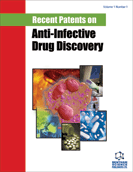Abstract
γδ T lymphocytes contribute to immune defense against infection through the production of cytokines, chemokines, anti-bacterial compounds, and killing of infected cells. The major subpopulation of human peripheral blood γδ T cells expresses a Vγ9Vδ2 T cell receptor. Vγ9Vδ2 T cells recognize at picomolar concentrations pyrophosphate molecules generated by bacteria and parasites through the 2-C-methyl-D-erythritol 4-phosphate (also termed 1-deoxy-Dxylulose 5-phosphate) pathway. Pyrophosphates including isopentenyl pyrophosphate (IPP) generated in mammalian cells through the alternative mevalonate pathway also activate Vγ9Vδ2 T cells, but require 1,000- to 10,000-fold higher concentrations. Synthetic compounds have been patented which efficiently activate Vγ9Vδ2 T cells in vitro and in vivo. In addition, the mevalonate pathway of IPP synthesis in mammalian cells can be manipulated by aminobisphosphonates and alkylamines, giving rise to the development of additional strategies for the therapeutic activation of anti-infective γδ T cells. The recent developments in the discovery of new and selective γδ T cell-activating compounds open new avenues for cell-based therapies of infectious diseases.
Keywords: Aminobisphosphonates, isopentenyl pyrophosphate, mevalonate pathway, phosphoantigen
Recent Patents on Anti-Infective Drug Discovery
Title: Small Molecules for the Activation of Human γ δ T Cell Responses Against Infection
Volume: 3 Issue: 1
Author(s): Dieter Kabelitz
Affiliation:
Keywords: Aminobisphosphonates, isopentenyl pyrophosphate, mevalonate pathway, phosphoantigen
Abstract: γδ T lymphocytes contribute to immune defense against infection through the production of cytokines, chemokines, anti-bacterial compounds, and killing of infected cells. The major subpopulation of human peripheral blood γδ T cells expresses a Vγ9Vδ2 T cell receptor. Vγ9Vδ2 T cells recognize at picomolar concentrations pyrophosphate molecules generated by bacteria and parasites through the 2-C-methyl-D-erythritol 4-phosphate (also termed 1-deoxy-Dxylulose 5-phosphate) pathway. Pyrophosphates including isopentenyl pyrophosphate (IPP) generated in mammalian cells through the alternative mevalonate pathway also activate Vγ9Vδ2 T cells, but require 1,000- to 10,000-fold higher concentrations. Synthetic compounds have been patented which efficiently activate Vγ9Vδ2 T cells in vitro and in vivo. In addition, the mevalonate pathway of IPP synthesis in mammalian cells can be manipulated by aminobisphosphonates and alkylamines, giving rise to the development of additional strategies for the therapeutic activation of anti-infective γδ T cells. The recent developments in the discovery of new and selective γδ T cell-activating compounds open new avenues for cell-based therapies of infectious diseases.
Export Options
About this article
Cite this article as:
Kabelitz Dieter, Small Molecules for the Activation of Human γ δ T Cell Responses Against Infection, Recent Patents on Anti-Infective Drug Discovery 2008; 3 (1) . https://dx.doi.org/10.2174/157489108783413218
| DOI https://dx.doi.org/10.2174/157489108783413218 |
Print ISSN 1574-891X |
| Publisher Name Bentham Science Publisher |
Online ISSN 2212-4071 |
 36
36Related Articles
-
Retracted: Effects of Vitamin K2 on Osteoporosis
Current Pharmaceutical Design Anti-Cancer / Anti-Tumor
Current Bioactive Compounds Exosomes: The Messengers of Health and Disease
Current Neuropharmacology Editorial from Guest Editor (DNA Methylation: A Target for Current and Future Therapies?)
Epigenetic Diagnosis & Therapy (Discontinued) Targeted Therapy for Advanced Renal Cell Cancer: Cytokines and Beyond
Current Pharmaceutical Design Strategic Developments & Future Perspective on Gene Therapy for Breast Cancer: Role of mTOR and Brk/ PTK6 as Molecular Targets
Current Gene Therapy Folate Receptor Targeted Liposomes Encapsulating Anti-Cancer Drugs
Current Pharmaceutical Biotechnology Apoptosis-related BCL2-family Members: Key Players in Chemotherapy
Anti-Cancer Agents in Medicinal Chemistry Preclinical Models to Study Breast Cancer
Clinical Cancer Drugs New-onset Diabetes Mellitus: Predictive Factors and Impact on the Outcome of Patients Undergoing Liver Transplantation
Current Diabetes Reviews Interactions of Liposomes with Cells In Vitro and In Vivo: Opsonins and Receptors
Current Drug Metabolism Isoform-Selective PI3K Inhibitors for Various Diseases
Current Topics in Medicinal Chemistry Cancer Vaccines: Emphasis on Pediatric Cancers
Current Pharmaceutical Design Natural Products and Transforming Growth Factor-beta (TGF-β) Signaling in Cancer Development and Progression
Current Cancer Drug Targets Protein kinases and the Hypoxia-Inducible Factor-1, two switches in angiogenesis
Current Pharmaceutical Design Effect of Cytostatic Drugs on the mRNA Expression Levels of Ribonuclease κ in Breast and Ovarian Cancer Cells
Anti-Cancer Agents in Medicinal Chemistry Anti-Gene Strategies to Down-Regulate Gene Expression in Mammalian Cells
Current Pharmaceutical Design Bcl-2 Inhibitors: Emerging Drugs in Cancer Therapy
Current Medicinal Chemistry Metabolism and Pharmacological Mechanisms of Active Ingredients in <i>Erigeron breviscapus</i>
Current Drug Metabolism Saffron-Based Crocin Prevents Early Lesions of Liver Cancer: In vivo, In vitro and Network Analyses
Recent Patents on Anti-Cancer Drug Discovery






















